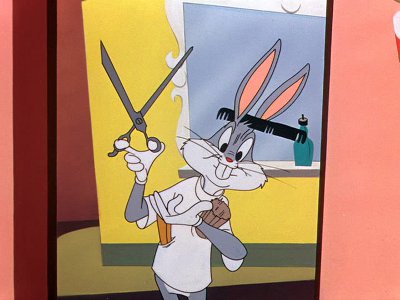 |
| Bugs Bunny as The Rabbit of Seville |
The music used here, the overture to The Barber of Seville, combines a delightful originality in the form of added lyrics, with one of the most familiar melodies in history, although I have to wonder how much of its presence in our cultural consciousness is due to its use in this short. Certainly there is a basic familiarity with opera, particularly the iconic tunes and images from Barber and Wagner's Ring, that those of us who grew up watching Bugs Bunny cartoons picked up subconsciously, without ever listening to a note of "serious" opera. I don't think it would be going too far to claim that Carl Stalling, the musical director of these films, did more for popular appreciation of opera than anyone else in the last century, a distinction I am certain he would be proud of. For all its mocking, the use of opera in Bugs is always affectionate, even reverent. For instance, The Rabbit of Seville utilizes the overture to Barber virtually in its entirety. Although a few repeated passages are truncated, and the tempo is faster than that conventionally used, the music is not otherwise cut or rearranged to suit the action on screen. From start to finish, the action is designed to fit the music.
The Rabbit of Seville, like Disney's Fantasia a decade earlier, begins by introducing the viewer to what they're about to see. Jones establishes the setting at The Hollywood Bowl, and the program, The Barber of Seville. We hear and see the orchestra tuning up. Bugs and Fudd rush in from outside, breathless from some chase they've been conducting on their own before the film started rolling. Their chase happens to take them on stage at the opera, a bewildered conductor takes this as his cue to start the overture, and the pair's antics become the performance.
 |
| Bugs Bunny and Elmer Fudd |
So, Bugs is a barber, and because he has a shop, Fudd must need a shave. Fudd submits to the inevitability of this logic, and takes a chair. Bugs climbs up onto the chair, pinning Fudd helplessly beneath him, and bares his blade. He wields his weapons like the seasoned killer we all know Bugs to be, and there is a demonic glint in his eye reminiscent of that other barber no one wants to visit. While we're here, I would like to suggest, although I certainly can't prove anything, that we could draw a straight line from this re-interpretation of Rossini's opera to Sondheim's Sweeney Todd. Although the legend of the Demon Barber of Fleet Street had been around at least since the 1840s, the first musical adaptation of the story was an English ballet by Sir Malcolm Arnold in 1959, followed by Sondheim's musical in 1979. The popularity and dissemination of Bugs Bunny is such that at the very least we can be reasonably certain that Sondheim had seen The Rabbit of Seville. I leave you to speculate on the rest.
 |
| Bugs' frenzied shave of Fudd. |
The Rabbit of Seville does not depart from the conventions of animated shorts of the day, it simply combines them with those of classical opera. In doing so, Jones and his team remind us, for those who need reminding, that opera itself can be funny, and need not always be taken too seriously, and that simple cartoons can be beautiful in their own right, and can reward a serious viewing with more than a few laughs.

Excellent look at this Chuck Jones classic! I grew up watching this (and later intro'd it to my kids). My daughter still does that head massage scene while she hums the melody. Thanks, Allex.
ReplyDelete